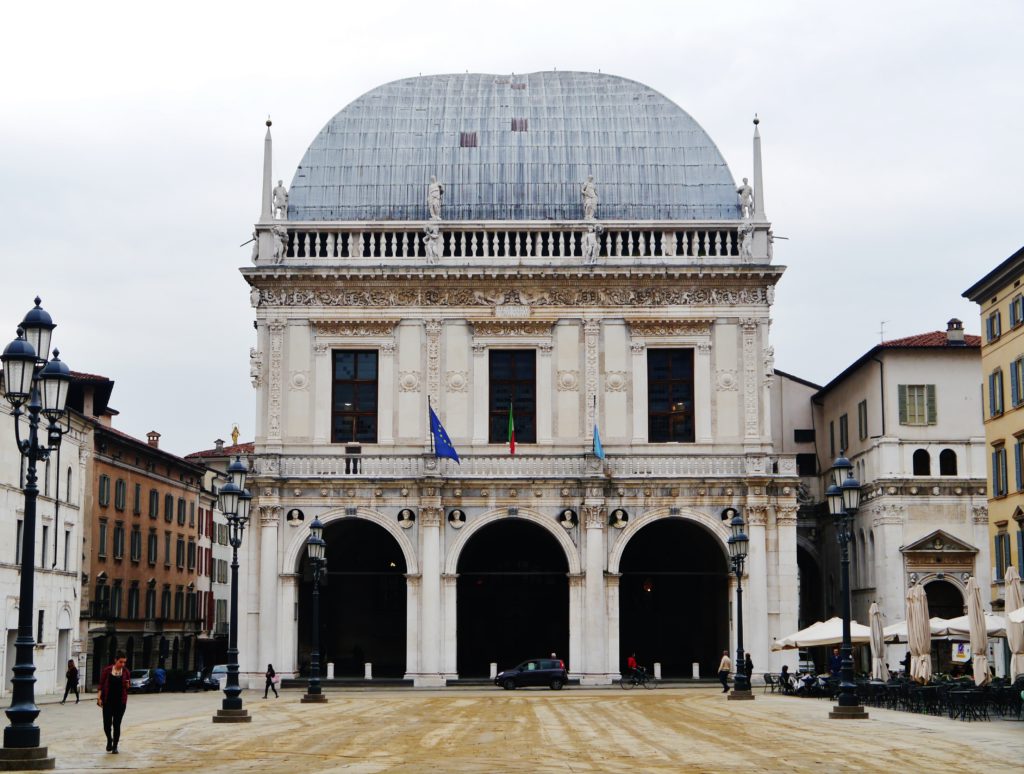The Renaissance palace is an example of domestic architecture during this era. It was the center of commercial and cultural life.

Image source: https://commons.wikimedia.org/wiki/File:Brescia_Piazza_della_Loggia_Palazzo_della_Loggia_2.jpg
The Importance of the Palace
The palace belongs to Renaissance domestic architecture. This structure was the large private townhouse of rich patricians. These buildings, occurring in a period of such innovations, are especially remarkable in the case of Florence, for being one of the greatest moments in the history of architecture. The palace is a fundamental stage in the elevation of domestic architecture as “fine arts”, and for contributing to the transformation of medieval cities in the Renaissance cities as we know it today. This innovating style was picked up by the rest of Italy as well as the rest of Europe and imitated for the next three centuries. The Renaissance great family’s habit of concentrating the households in a structure derived from the Communal Era, in order to be geographically located. It was also important for the members’ security, considering the feuds between families. For this reason, new proliferating families, as they proliferated in politics, tended to cluster together. The Renaissance period was also famous for patronage, and the palace was a cultural center itself. Artists were invited to join the court in order to realize patrons’ commission, and sometimes masters’ workshops were built nearby or inside the palace, with commercial activities overlooking the streets.

Image source: https://en.wikipedia.org/wiki/Palazzo_Farnese
A Compositional Harmony from the Past
The architecture of the palace is a testimony of the lively and dynamic cultural climate. The style defined a new identity, in opposition to the “crude” buildings of the Communal era. The domestic style reflects the Renaissance taste and its fascination for classical Roman architecture. The compositional harmony was the main feature of the palace (and other Renaissance buildings): it typically features a square, symmetrical appearance in which proportions are usually based on a module, and Roman-inspired elements, such as colonnades, arches, and facades. The facades are organized in pilasters, arches, entablatures, and are symmetrical around the vertical axis. Even windows were paired and set within a semicircular arch, such as Palazzo Farnese in Rome. Sometimes they were decorated with frescoes or “sgraffiti”. The external walls were generally of highly finished ashlar masonry, laid in straight courses. The corners were often emphasized by rusticated quoins. Basements and ground floors were sometimes rusticated, as modeled on the Palazzo Medici Riccardi in Florence. The interiors were often adorned with wooden furniture, frescoes, eye-catching decorations. This architectural style spread across Italy, and in some cases, was reproduced in different variations. In Venice, the palace expressed its own identity, as is exemplified by Palazzo Corner-Spinelli and Palazzo Vendramin-Calergi, both of which were realized by Coducci. These buildings feature large and numerous windows. Moreover, the structure is clearly more open than the palaces found in Florence and the rest of central Italy.

Image source: https://it.m.wikipedia.org/wiki/File:Palazzo_Strozzi_-_panoramio.jpg
Palazzo Medici Riccardi
Palazzo Medici Riccardi is an outstanding example of a Renaissance palace. Probably it was is the first Renaissance building erected in Florence and an archetype of the rising style. This structure was built nearby the church of San Lorenzo for Cosimo de Medici (the patriarch of the Medici family), thanks to the work of Michelozzo, a follower of the famous Brunelleschi. Medici attained political power thanks to their success in commercial and banking and ruled Florence in that period. The palace is characterized by rusticated floors and a cornice, which runs along the roofline. It features arched windows and a partially closed loggia on the corner. A central, decorated courtyard is accessible through two doors, and it was built following the model of Brunelleschi. Later the palace was also the residence of Lorenzo the Magnificent, the most famous patron in history.

Image source: https://en.wikipedia.org/wiki/Palazzo_Medici_Riccardi
Info source:
https://en.wikipedia.org/wiki/Palazzo_Medici_Riccardi
https://en.wikipedia.org/wiki/Renaissance_architecture#Architectural
https://www.britannica.com/art/Western-architecture/Early-Renaissance-in-Italy-1401-95
https://courses.lumenlearning.com/boundless-arthistory/chapter/renaissance-architecture/
http://www.museumsinflorence.com/musei/medici_riccardi_palace.html
https://www.florenceinferno.com/the-medici-family/#who-were-the-medici
